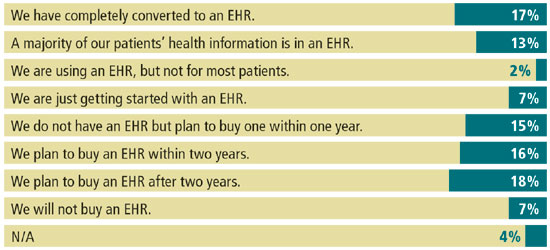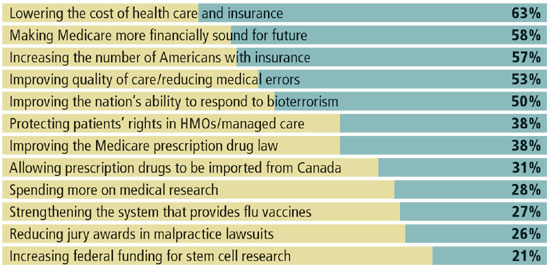
Fam Pract Manag. 2005;12(2):27-28
EHR certification process to begin by summer
The Certification Commission for Healthcare Information Technology (CCHIT), developed last fall, is working to establish a voluntary product certification process for electronic health records (EHRs), primarily those used in physician offices and other ambulatory settings. The commission believes that EHR certification would reduce physicians' risk when investing in EHRs, encourage payers and purchasers to offer physicians incentives for adopting EHRs, and help ensure that products are capable of interacting with emerging local and national health information infrastructures.
The commission intends to put in place a pilot “first-step” certification process by the summer of 2005. In subsequent years, the commission will introduce second- and third-step certifications, which will be increasingly thorough.
The commission was formed by the American Health Information Management Association, the Healthcare Information and Management Systems Society, and the National Alliance for Health Information Technology. Its members include representatives from the physician, payer and vendor communities, including Doug Henley, MD, executive vice president of the AAFP.
Most family physicians will convert to electronic health records, says survey
When asked where they stood on the road to EHR implementation, 39 percent of family physicians said they have either converted entirely to an EHR or are in the process of doing so, according to an AAFP survey of 788 physicians from 21 state chapters. Of the respondents who have an EHR, 73 percent indicated that it has improved the health of their patients, in part by reducing prescribing errors and enhancing patient communication. Nearly 50 percent of respondents said they intend to buy an EHR, with most planning to do so within one or two years.
Which best describes your office's status regarding electronic health records?

Note: Percentages do not equal 100 due to rounding. Source: AAFP, July 2004.
Malpractice premiums decline in at least one state
Physicians Insurance, which provides malpractice insurance to about 70 percent of physicians in Washington state, has said it will reduce premiums by 7.7 percent in 2005, after posting record profits of $10 million last year, the Jan. 10 Seattle Times reported. In 2004, the company raised premiums by about 19 percent. A spokesman for the insurance company said, despite the decrease for 2005, physicians' premiums are still “unreasonably high” and the company will continue to support tort reform. The state currently has no caps on awards in malpractice cases, although several initiatives are being debated.
For 2005, family physicians in the state who provide obstetrical services will face premiums of $16,977 on average, down from more than $19,000 in 2004. In comparison, rates for obstetricians/gynecologists will average more than $66,000 in 2005, a “substantial” decrease from 2004.
State Insurance Commissioner Mike Kreidler said the drop in premiums may signal a turnaround in the market. “We've clearly turned a corner,” Kreidler said. “It's gone beyond being stable; we're seeing strong improvements.”
Two other insurers in the state, the Doctors Company and GE Medical Protective, are asking for increases of 7.1 percent and 22.6 percent, respectively. However, they insure relatively few physicians in the state, and their increases are smaller than those enacted in 2004.
Public weighs in on top health care priorities
Lowering the costs of health care and health insurance should be the top priority for Congress and the Bush administration, say U.S. residents, according to a new survey of 1,396 adults from the Kaiser Family Foundation and the Harvard School of Public Health. Second on the list was making Medicare financially sound for the future. Reducing malpractice awards ranked eleventh on the list.
Percentage of respondents rating each of the following a top priority

Source: Kaiser Family Foundation/Harvard School of Public Health. Health Care Agenda for the New Congress. November 2004.
ABFM extends SAM deadline
Physicians who recertified with the American Board of Family Medicine in 2003 have been granted a one-time extension for completing their first self-assessment module (SAM). Under the ABFM's new maintenance of certification program, diplomates are required to complete one SAM per year. The first SAMs were due by Dec. 31, 2004, but diplomates now have until April 15. The ABFM allowed more time because the requirements are new and were surrounded by much debate. To take advantage of the extension, physicians must call the board's help desk at 877-223-7437 or e-mailabfphd@abfp.org. Diplomates required to complete a SAM for 2005 will need to do so by Dec. 31, 2005.
The downside of physician report cards
Nearly 80 percent of cardiologists in New York say they have avoided performing angioplasties on patients who have low probabilities of survival out of fear that the patient's death would skew the data on their physician report card, according to a survey of 120 cardiologists from the School of Medicine and Dentistry at the University of Rochester. New York is one of a handful of states to publish physician report cards that include mortality data. “While these reports attempt to provide the public with objective information about physician quality, they can in some instances create a conflict for the physician that may actually worsen patient care,” said Craig Narins, MD, principal investigator for the study.
Suit against health plans upheld
The Supreme Court has declined to hear an appeal filed by several health insurers to stop a class-action lawsuit brought by more than 600,000 physicians over claims that the companies conspired to delay or deny reimbursement to physicians. The lawsuit involves Humana Health Plan, PacifiCare Health Systems, United Health care, Well Point Health Networks, Prudential Insurance Company of America and Health Net. Aetna and Cigna were also named as defendants in the lawsuit but have settled out of court for more than $300 million. The class-action suit will proceed in September. Some observers say the Supreme Court's action may pressure the remaining insurers to settle as well.
Health care spending trends
Health care spending reached $1.7 trillion in 2003, or 15.3 percent of the gross domestic product, according to an annual report from the Centers for Medicare & Medicaid Services. Total health care spending increased by 7.7 percent, exceeding overall U.S. economic growth by three percentage points; however, it was the lowest rate of growth in seven years. The report noted that premiums for private health insurance increased by 9.3 percent, while administrative costs and health insurer profits totaled 13.6 percent of premiums, the highest rate in over a decade. Patients' out-of-pocket spending increased by 7.6 percent. Spending on physician services increased by 8.5 percent.
Restrictions on diagnostic imaging
The rate of diagnostic imaging services for Medicare beneficiaries has been rising at an alarming pace, according to the Medicare Payment Advisory Commission (MedPAC). To encourage appropriate use of such services, MedPAC has recommended that the Centers for Medicare & Medicaid Services (CMS) begin measuring providers' use of imaging services and present providers with data comparing their use to peer benchmarks. MedPAC also recommended that CMS set quality standards for all providers who bill Medicare for performing or interpreting diagnostic imaging. Congress is currently considering MedPAC's recommendations.
New Rx discount program for uninsured
This month, 11 pharmaceutical companies are launching a new prescription drug discount card program, Together Rx Access. The program offers discounts on 275 brand-name medications and a number of generic medications to individuals under the age of 65 who do not have public or private prescription drug coverage. Participants' annual incomes must not exceed $30,000 for individuals, $40,000 for couples, $50,000 for a family of three and $60,000 for a family of four. The pharmaceutical companies estimate that about 80 percent of the 45 million uninsured U.S. residents will qualify for the program. Discounts for brand-name treatments will range from 25 percent to 40 percent. For more information, visit http://www.togetherrxaccess.com